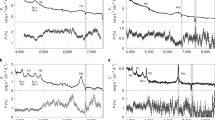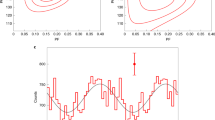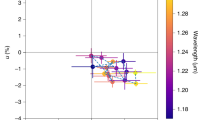Abstract
Polarimetry done by Schwarz and Mundt1 on the type II supernova 1987A on 6 and 7 March 1987 showed variation in polarization across line profiles (see Table 1). This polarization structure is interpreted as arising from an asymmetric, homologously expanding, scattering atmosphere surrounding an asymmetric continuum-producing photosphere. Resonant scattering of radiation by ions in the atmosphere produces the line structure in the flux spectrum and polarizes the emergent radiation. The asymmetric shape of the atmosphere causes a non-zero net polarization. Sobolev-method radiative transfer calculations with axisymmetric oblate ellipsoidal models have been carried out to fit the observed data. The models are parameterized by the ratio of the symmetry axis to the perpendicular axis, c/a. The fits to the 1987A data indicate that (c/a) is ~0.6–0.8.
This is a preview of subscription content, access via your institution
Access options
Subscribe to this journal
Receive 51 print issues and online access
$199.00 per year
only $3.90 per issue
Buy this article
- Purchase on Springer Link
- Instant access to full article PDF
Prices may be subject to local taxes which are calculated during checkout
Similar content being viewed by others
References
Schwarz, H. E. & Mundt, R. Astr. Astrophys. 177, L4–L4 (1987).
Sobolev, V. V. Moving Envelopes of Stars (Harvard University Press, Cambridge, 1960).
Rybicki, G. B. & Hummer, D. G. Astrophys. J. 219, 654–675 (1978).
Olson, G. L. Astrophys. J. 255, 267–277 (1982).
Branch, D. in Supernovae Spectra (eds Meyerott, R. & Gillespie, G. H.) 39–48 (American Institute of Physics, New York, 1980).
Branch, D. et al. Astrophys. J. 252, L61–L64 (1982).
Branch, D., Dogget, J. B., Nomoto, K. & Thielemann, F.-K. Astrophys. J. 294, 619–625 (1985).
Chandrasekhar, S. Radiative Transfer (Dover, New York, 1960).
Danziger, I. J. et al. Astr. Astrophys. 177, L13–L16 (1987).
Barrett, P. IAU Circ. no. 4337 (1987).
Shapiro, P. R. & Sutherland, P. G. Astrophys. J. 263, 902–924 (1982).
McCall, M. L. in Supernovae as Distance Indictors (ed. Bartel, N.) 48–61 (Springer, Berlin, 1985).
Müller, E. & Hillebrandt, W. Astr. Astrophys. 103, 358–366 (1981).
Gunn, J. E. & Ostriker, J. P. Nature 21, 454–456 (1969).
Bouchet, R. et al. Astr. Astrophys. 177, L9–L12 (1987).
Author information
Authors and Affiliations
Rights and permissions
About this article
Cite this article
Jeffery, D. The polarization spectrum of supernova 1987A interpreted in terms of shape asymmetry. Nature 329, 419–421 (1987). https://doi.org/10.1038/329419a0
Received:
Accepted:
Issue Date:
DOI: https://doi.org/10.1038/329419a0
This article is cited by
-
An atlas of the optical spectrum of supernova 1987A in the large magellanic cloud
Journal of Astrophysics and Astronomy (1990)
-
Asymmetry of the envelope of supernova 1987A
Nature (1989)
-
Spectroscopic observations of SN1987a in the LMC
Journal of Astrophysics and Astronomy (1988)
Comments
By submitting a comment you agree to abide by our Terms and Community Guidelines. If you find something abusive or that does not comply with our terms or guidelines please flag it as inappropriate.



